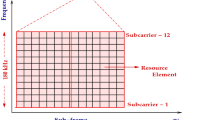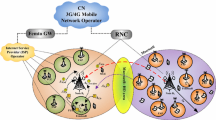Abstract
This paper presents two novel frameworks for session admission control and resource reservation in the context of next generation mobile and cellular networks. We also devised a special scheme that avoids per-user reservation signaling overhead in order to meet scalability requirements needed for next generation multi-access networks. The first proposal, Distributed Call Admission Control with Aggregate Resource Reservation (VR), uses mobility prediction based on mobile positioning system location information and takes into account the expected bandwidth to be used by calls handing off to and from neighboring cells within a configurable estimation time window. In conjunction, a novel concept called virtual reservation has been devised to prevent per-user reservation. Our second proposal, Local Call Admission Control and Time Series-based Resource Reservation, takes into account the expected bandwidth to be used by calls handed off from neighboring cells based only on local information stored into the current cell a user is seeking admission to. To this end, we suggest the use of two time series-based models for predicting handoff load: the Trigg and Leach (TL), which is an adaptive exponential smoothing technique, and Autoregressive Integrated Moving Average (ARIMA) that uses the Box and Jenkins methodology. It is worth to emphasize that the use of bandwidth prediction based on ARIMA technique still exist for wireless networks. The novelty of our approach is to build an adaptive framework based on ARIMA technique that takes into account the measured handoff dropping probability in order to tuning the prediction time window size so increasing the prediction accuracy. The proposed schemes are compared through simulations with the fixed guard channel (GC) and other optimized dynamic reservation-based proposals present in the literature. The results show that our schemes outperform many others and that the simpler local proposal based on TL can grant nearly similar levels of handoff dropping probability as compared to those from more the complex distributed approach.














Similar content being viewed by others
References
Bow, L., & Leroy, W. (2001). Toward an all-IP based UMTS system architecture. IEEE Network, 15(1), 36–45.
Newman, P. (2004). In search of the all-IP mobile network. IEEE Radio Communications, 42(12), S3–S8.
Braden, R., et al. (1994). Integrated services in the Internet architecture: An overview, IETF RFC 1633, June.
Blake, S., et al. (1998). An architecture for differentiated services, IETF RFC 2475, December.
Nichols, K., et al. (1999). A two-bit differentiated services architecture for Internet. RFC 2638, June.
Harvey, A. C. (1993). Time series models (2nd ed.). Cambridge: MIT Press.
Zhang, T., et al. (2001). Local predictive resource reservation for handoff in multimedia wireless IP networks. IEEE Journal on Selected Areas in Communications, 19(10), October.
Dias, K. L., Fernandes, S. F. L., & Sadok, D. H. F. (2003). Predictive call admission control for all-ip wireless and mobile networks. IFIP/ACM Latin America Networking Conference, 2003. pp. 131–139.
Hong, D., & Rappaport, S. (1986). Traffic model and performance analysis for cellular mobile radio telephone systems with prioritised and nonprioritised handoff procedures. IEEE Transactions on Vehicular Communications, 35(3), 77–92.
Oliveira, C., Kim, J. B., & Suda, T. (1998). An adaptive bandwidth reservation for high-speed multimedia wireless networks. IEEE Journal on Selected Areas in Communications, 16(6), 858–874.
Choi, S., & Shin, K. G. (1998). Predictive and adaptive bandwidth reservation for handoffs in QoS sensitive cellular networks. In Proceedings of ACM SIGCOMM´98.
Chiu, M. H., & Bassiouni, M. A. (2000). Predictive schemes for handoff prioritization in cellular networks based on mobile positioning. IEEE Journal on Selected Areas in Communications, 18(3), March.
Xu, Z., et al. (2002). A new adaptive channel reservation scheme for handoff calls in wireless cellular networks. In Proceedings of IFIP Networking 2002, pp. 672–684.
Soh, W. S., & Kim, H. S. (2004). Dynamic bandwidth reservation in cellular networks using road topology based mobility predictions. IEEE INFOCOM, Hong Kong, March, 2004.
Soh, W.-S., & Kim, H. S. (2003). QoS provisioning in cellular networks based on mobility prediction techniques. IEEE Communications Magazine, January, 86–92.
Diederich, J., & Zitterbart, M. (2005). A simple and scalable handoff prioritization scheme. Elsevier Computer Communications, 28, 773–789.
Rozic, N., & Kandus, G. (2004). MIMO ARIMA models for handoff resource reservation in multimedia wireless networks. Wiley Wireless Communications and Mobile Computing, 4, 497–512.
Naghshineh, M., & Schwartz, M. (1996). Distributed call admission control in mobile/wireless networks. IEEE Journal on Selected Areas in Communications, 14(4), 711–717.
Jiang, S., Li, B., Luo, X., & Tsang, D. (2001). A modified distributed call admission control scheme and its performance. Wireless Networks, 7(2), 127–138.
Wu, S., Wong, K. Y., & Li, B. (2002). A dynamic call admission policy with precision QoS guarantee using stochastic control for mobile wireless networks. IEEE/ACM Transactions on Networking, 10(2), 257–271.
Ghaderi, M., & Boutaba, R. (2006). Call admission control in mobile cellular networks: A comprehensive survey. Wireless Communications and Mobile Computing, 6(1), 69–93.
Zhao, Y. (2002). Standardization of mobile phone positioning for 3G systems. IEEE Communication. Magazine, July, 108–116.
Dias, K. L., Fernandes, S., & Sadok, D. F. H. (2007). Qos provisioning in mobile networks based on aggregate bandwidth reservation. ISPA 2007, Toronto, Canada.
Zhang, Z.-L., et al. (2001). On scalable design of bandwidth brokers. IEICE Transactions on Communications, E84-B(8), August.
Thomas, E., et al., (2003). AQUILA: Adaptive resource control for QoS using an IP-based layered architecture. IEEE Communication Magazine, January, 46–53.
Dommety, G., et al. (2002). Fast handovers for mobile IPv6, Internet Draft, IETF, March 2002, Work in progress.
Trossen, D., et al. (2002). Protocol for candidate access router discovery for seamless IP-level handovers, draft-trossen-seamoby-cardiscovery-04.txt, Work in progress, October.
Soliman, H., Castelluccia, C., Malki, K., & Bellier, L. (2001). Hierarchical MIPv6 mobility management, Internet Draft, IETF, July, Work in progress.
Elwalid, A. I., & Mitra, D. (1993). Effective bandwidth of General Markovian traffic sources and admission control of high-speed networks. IEEE/ACM Transactions on Networking, 1, 329–343.
Guerin, R., Ahmadi, H., & Naghshineh, M. (1991). Equivalent capacity and its application to bandwidth allocation in high-speed networks. IEEE Journal on Selected Areas in Communications, 9, 968–981.
Jiang, S., Li, B., Luo, X., & Tsang, D. H. K. (2001). A modified distributed call admission control scheme and its performance. Wireless Networks, 7(2), 127–138.
TR 25.814 v.7.0.0 “Physical Layer Aspects for Evolved UTRA”.
R2-061953 “Uplink Scheduling Based on Neighbour Cell Load”, Qualcomm Europe.
Sang, A., & Li, A. (2000). Predictability analysis of network traffic. IEEE INFOCOM’2000, March.
Wu, S., Wong, K. Y. M., & Li, Bo. (2002). A dynamic call admission policy with precision QoS guarantee using stochastic control for mobile wireless networks. ACM/IEEE Transactions on Network, 10(2), 257–271.
Sadeghi, B., & Knightly, E. W. (2003). Architecture and algorithms for scalable mobile QoS. Wireless Networks, 9(1), 7–20.
Yu, F., & Leung, V. C. M. (2001). Mobility-based predictive call admission control and bandwidth reservation in wireless cellular networks. IEEE INFOCOM’01, pp. 518–526.
Soh, W.-S., & Kim, H. S. (2003). QoS provisioning in cellular networks based on mobility prediction techniques. IEEE Communication Magagazine, January, 86–92.
Chuah, C. N., et al. (2000). QoS provisioning using a clearing house architecture. IEEE/IFIP Eigth International Workshop on Quality of Service (IWQOS’2000), June.
Casetti, C., Kurose, J., & Towsley, D. (1996). An adaptive algorithm for measurement-based admission control in integrated services packet networks. International Workshop on Protocols for High Speed Networks, Sophia Antipolis.
Duffield, N. G., Goyal, P., Greenberg, A., Mishra, P., Ramakrishnan, K. K., & der Merwe, J. E. V. (1999). A flexible model for resource management in virtual private networks. In ACM Sigcomm, San Diego, California, USA.
Trigg D. W., & Leach D. H. (1967). Exponential smoothing with an adaptive response rate. Operational Research Quarterly, 18, 53–59.
Taylor, J. W. (2004). Smooth transition exponential smoothing. Journal of Forecasting, 23(6), 385–404.
Dias, K. L., Fernandes, S., & Sadok, D. F. H. (2007). Qos provisioning in mobile networks based on aggregate bandwidth reservation. In 5th International Symposium on Parallel and Distributed Processing and Applications, ISPA 2007, Canada, August 29–31, 2007, in Lecture Notes in Computer Science 4742 Springer 2007, pp. 908–919, ISBN 978-3-540-74741-3.
Author information
Authors and Affiliations
Corresponding author
Rights and permissions
About this article
Cite this article
Dias, K.L., Sadok, D.F.H., Fernandes, S.F.L. et al. Approaches to resource reservation for migrating real-time sessions in future mobile wireless networks. Wireless Netw 16, 39–56 (2010). https://doi.org/10.1007/s11276-008-0113-6
Published:
Issue Date:
DOI: https://doi.org/10.1007/s11276-008-0113-6




